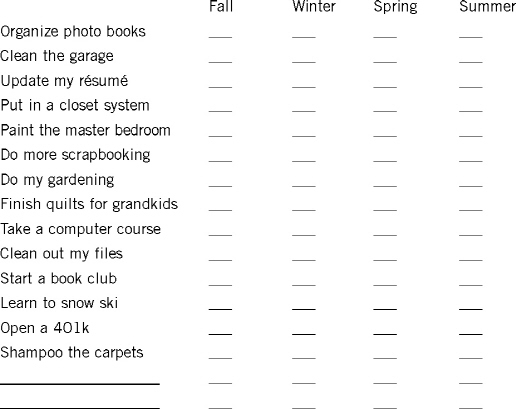
Pursue a Personal Project List

If setting deadlines for yourself has never worked before, it’s because you kept those dates in your head (or your pocket calendar, where you never look six months ahead). In your head there is no time! In your head it is always now.
—Barbara Sher
Have you noticed how some items keep cropping up on your to-do list, but you never start them? Chances are they’re not the kind of to-dos that can be completed in one day. They require more time and attention. So put them on a project list.
The two lists are practically cousins. One supports the other. A to-do list covers daily action steps. A project list includes larger tasks that take more time and steps. Both help you focus your time and attention on things you need or want to do and will benefit from doing.
But I Already Have Project Lists!
Diane was in my audience when we talked about project lists. She was excited to share a personal victory. “I’m a teacher, and I save all my projects for the summer. Last summer, I wrote a two-page list on a legal pad and posted it on the back door. I looked at it every day and felt so organized.”
I admired her enthusiasm. “So how did it go?” I asked. “Did you complete some significant projects?” I expected to hear about organized closets, the family room redecorated, paper piles filed, and afternoons as a family spent at the pool once the morning work was finished.
But Diane looked a bit sheepish. “Well, actually . . . I didn’t do any of them. It just felt good to have them listed,” she concluded. “I suppose that’s not enough, right?”
To help Diane get on track with her projects, I shared with her three important things about project lists:
1. Put no more than ten items on your project list. Don’t add another one until you complete one or cross it off.
2. Assign each project a beginning and ending time on your calendar. Half the battle is starting, and the other half is working through to completion. Keep your momentum going by regularly including a small to medium project as part of your lifestyle.
3. Decide if this is a short monthly or longer seasonal project. A monthly project can be written in the top margin of your monthly calendar. Generally, you can accomplish three projects per month for home or work if you stay focused and look for pockets of time to work on them. A seasonal project is categorized as fall, winter, spring, or summer. Post or tape the name of the project to a spot you see each day, such as your computer monitor, bathroom mirror, or kitchen bulletin board.
Diane’s Seasonal Project List
“Oh, I see,” said Diane. “I need to limit my list, pick a time frame, and then start on projects that are small and manageable.”
“That’s right,” I replied. “We’re more likely to finish things that are divided into small pieces. If they’re too big, we procrastinate and never start.” I gave her an example of what her list could look like for the summer:
 Put kids’ papers in a memory book.
Put kids’ papers in a memory book.
 Clean up my desk.
Clean up my desk.
 Decorate my “blah” bedroom.
Decorate my “blah” bedroom.
Diane laughed at decorating her “blah” bedroom. “It has an old bedspread I never liked. I’m going to replace it, paint the room, and hang some new pictures. Mornings are hard enough without waking up to a depressing room.” And she agreed, “Putting away my kids’ papers and mine would be a great way to start the summer. What a lift it would give to do even one decorating project a year.”
STEP 1: PICK YOUR PROJECTS FOR THE YEAR
What changes would you like to make in your life? Check off the boxes below that interest you, or add your own projects.

It’s usually best to add items that you can envision yourself doing in the near future that will either make an area beautiful or make your day-to-day life easier.
STEP 2: MARK THE APPROPRIATE SEASON FOR EACH PROJECT
Most people make a project list—and want everything done by the end of next weekend! Since your time is already full, find projects that are motivating enough for you to redirect your time and energy over a month or a quarter. Then go back to the list and mark which season best fits each project. For example:
Fall: Start a project—take a self-improvement course, create a scrap-book to share at the holidays, make craft projects for Christmas gifts, update financial plans.
Winter: Inside projects—organize photo books, clean out files, take a computer course.
Spring: Outside projects—take a spring break vacation, clean the garage, shampoo the carpets, plant your garden.
Summer: Light projects—update your résumé, repair the grandfather clock, be outside, vacation with family and friends, paint and deco-rate a bedroom.
STEP 3: SEQUENCE THE PROJECTS INTO A SEASONAL TIMELINE
Post a timeline (such as this one) where you will see it regularly. Once you set a target and a date, you will start noticing things that will help you make it happen.
| WINTER | SPRING | SUMMER | FALL |
|---|---|---|---|
| Organize DVDs and CDs (January-February) | Plant the garden and clean the yard and garage (April-May) | Paint and decorate my bedroom (July-August) | Start a new class (September- October) |
Start a file or two-pocket folder for each project, and keep adding ideas as they come up. When you approach your season to begin, create an action plan in a list of sequential steps taped to the front cover of the folder. Set a start date and the time allowed, and coordinate the timeline with your calendar. Leverage it before an event or holiday, but allow three weeks’ leeway to finish up.
How Does Tackling a Project Simplify My Time?
Sometimes it might feel like a better use of your time to do nothing. Why rock the boat? At times, this can be a wise choice. On the other hand, taking action can bring peace and order. After all, if you have to view a messy space or an undecorated room each day, you will develop “visual tuneout” and never notice it . . . until the day the Realtor makes you fix it so you can sell your home. Do it now, and enjoy the results while you live there.
During a radio show on which I was the guest, one caller had a challenging scenario. Lilly was a frazzled mother of two high-energy preschoolers who needed her constant attention. She lamented, “When will I have time to get my photos into albums? And I have all these boxes of old papers that I have to go through.”
Generally, I suggest people list projects by season, but in her case I had a different suggestion. “Simply label the photos with the year and grade level of the children, place the newest ones in front, and put them in a labeled decorative photo box. When it’s the right time, perhaps when the kids are in grade school, you’ll be able to get the photos in books for each of their birthdays. After that, they will be easier to maintain.”
Lilly, like so many people I’ve spoken with, let out a sigh of relief. She realized that she didn’t need to pressure herself beyond what she was able. All she needed to do was to label the year and topic on the outside of the well-ordered photo boxes. Even a small temporary step can simplify your time.
The Rewards of Projects
Lisa, a working single gal in her twenties, decided that during her one-week vacation between Christmas and New Year’s, she would go through all ten boxes of her school papers and sort them. Next she would redecorate her room, replacing her childhood decorations with those of a young professional.
While Lisa sorted from morning to night, her dad painted the high ceiling and walls and moved furniture with her brother. She and her mom gathered decorating tips from Ethan Allen. Lisa was able to complete all this in her ten-day time span.
When she returned to work, Lisa discovered that her professional life picked up when she put her personal space in order. People sensed she was in control, and they respected her for it. The same can be true for you.
It’s Your Time
Pursue a Personal Project List (Time Tool #3)
□ Finish a project to show you can do it!
□ Find a partner or mentor to guide you through the next project.
□ Start a project that you can successfully complete soon.
The secret of getting ahead is getting started. The secret of getting started is breaking your complex overwhelming tasks into small manageable tasks, and then starting on the first one.
—Mark Twain